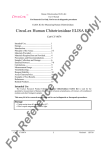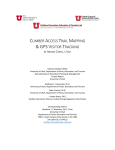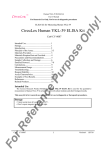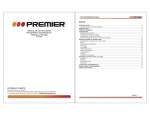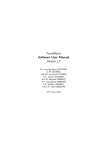Download Data Sheet
Transcript
Quantitative test kit for chitotriosidase activity On ly! Chitotriosidase Fluorometric Assay Kit User’s Manual For Research Use Only, Not for use in diagnostic procedures CycLex Chitotriosidase Fluorometric Assay Kit For 100 Assays Pu Intended Use................................................1 Storage.........................................................1 Introduction..................................................2 Principle of the Assay..................................3 Materials Provided.......................................3 Materials Required but not Provided...........4 Precautions...................................................4 Detailed Protocol..........................................5-8 Evaluation of Results...................................9-10 Troubleshooting...........................................11 Reagent Stability..........................................11 References....................................................11-12 Related Products..........................................13 rp os e Cat# CY-1249 Intended Use ce The CycLex Research Product CycLex Chitotriosidase Fluorometric Assay Kit is used for the quantitative measurement of chitotriosidase activity in serum/plasma, culture supernatant of activated macrophages and other biological samples. en Applications for this kit include: 1) Measuring chitotriosidase activity in serum/plasma and other biological samples. 2) Evaluating the effects of pharmacological compounds on chitotriosidase activity. 3) Screening inhibitors or activators of chitotriosidase. Storage er This assay kit is for research use only and not for use in diagnostic or therapeutic procedures. rR ef • Upon receipt store Recombinant Chitotriosidase at -70°C and all other components below -20°C. • Don’t expose reagents to excessive light. Fo Cat#: CY-1249 1 Version#: 121011 On ly! Chitotriosidase Fluorometric Assay Kit User’s Manual For Research Use Only, Not for use in diagnostic procedures Introduction rR ef er en ce Pu rp os e Chitotriosidase was discovered in plasma of patients suffering from Gaucher’s disease; it was found that the 1,000-fold-elevated enzyme originates from lipid-laden macrophages that accumulate in various tissues of Gaucher’s patients (1). Chitotriosidase has subsequently been purified from the spleen of a Gaucher’s patient and its cDNA was cloned from a human macrophage cDNA library (2, 3). This enzyme is a human chitinase member of family 18 glycosyl hydrolases (3–5), and has the capability to hydrolyze chitin. This enzyme is selectively expressed in activated tissue macrophages that accumulate in various tissues of several lysosomal diseases (6). Therefore its activity has been proposed as a biochemical marker of macrophage accumulation in Gaucher’s disease (1, 7). In some other inherited lysosomal storage disorders, especially sphingolipidoses such as Niemann Pick, GM1-gangliosidosis, and Krabbe disease, which involve accumulation of different lipids, more modest elevations in plasma chitotriosidase have been noted (7). Chitotriosidase is the only biomarker identified up to date for the monitoring the efficacy of the extremely costly enzyme-replacement therapy of Gaucher patients and male Fabry patients (8). Elevated levels of serum chitotriosidase were also found in disorders caused by the abnormal activation of immune system, including sarcoidosis (9) and atherosclerosis (10, 11). It has been shown that chitotriosidase activity was elevated up to 55-fold in extracts of atherosclerotic tissue, showing a clear connection between chitotriosidase expression and lipid-laden macrophages inside human atherosclerotic vessel wall (10). Human chitotriosidase also associates with pathogen-driven diseases, and in particular with fungal infections, suggesting the role of this enzyme in host defense against chitin-containing pathogens (12, 13). Other clinical data for instance show that chitotriosidase activity is raised in plasma of African children infected with acute Plasmodium falciparum malaria (14). Additional evidence for a role of chitotriosidase during immunological responses is the observation that the enzyme is shortly and acutely up-regulated both at the level of mRNA and activity following stimulation with prolactin, IFN-γ, TNF α and LPS, but not with IL-10 (15, 16). In the blood stream, tissue macrophages largely secrete newly synthesized 50-kDa chitotriosidase, but about one-third is directly routed to lysosomes and proteolytically processed to the 39-kDa unit that remains catalytically active (17). A common chitotriosidase gene polymorphism leads to a null allele and therefore a defective enzyme activity. In white populations, 30% to 40% of individuals are carriers of this abnormal chitotriosidase allele and approximately 6% are homozygous (1, 18). Fo Cat#: CY-1249 2 Version#: 121011 Principle of the Assay On ly! Chitotriosidase Fluorometric Assay Kit User’s Manual For Research Use Only, Not for use in diagnostic procedures The CycLex Chitotriosidase Fluorometric Assay Kit is based on an exclusive fluorescence substrate, 4-Methylumbelliferyl-β-D-N,N’,N”-triacetylchitotriose. This homogenous assay kit is sensitive and convenient. Summary of Procedure rp os e Dispense 5 µL of sample or Recombinant chitotriosidase in the well. Add 95 µL of 1X Fluoro-Substrate solution. Measure velocity of fluorescence intensity with excitation at 340-380 nm and emission at 440-460 nm for 30-60 min at 30°C. Each kit contains Materials Pu Materials Provided ce ①10X Chitotriosidase Assay Buffer ②50X Fluoro-Substrate (1 mM 4 MU-chitotrioside*) ③Recombinant Chitotriosidase ** (ca. 5 µg/ml) ④4-Methylumbelliferone standard (100 µM) ⑤Instruction manual Quantity 1.0 mL x 2 220 µL x 1 Storage Below -20°C Below -20°C 50 µL x 1 200 µL x 1 1 -70°C Below -20°C room temp. rR ef er en * 4-Methylumbelliferyl-β-D-N,N’,N”-triacetylchitotriose ** Recombinant human chitotriosidase expressed in HEK293 cells. Fo Cat#: CY-1249 3 Version#: 121011 On ly! Chitotriosidase Fluorometric Assay Kit User’s Manual For Research Use Only, Not for use in diagnostic procedures Materials Required but not Provided • Allosamidin: Allosamidin is available from 2A PharmaChem; cat#. 2A-300198 (CAS number 103782-08-7). • Microplate suitable for use with a fluorometric plate reader (black microplates provide better signal to noise ratio) rp os e • Microplate reading fluorometer: capable of excitation at a wavelength in the range 340-380 nm and detection of emitted light in the range 440-460 nm • Pipettors: 2-20 µL, 20-200 µL and 200-1000 µL precision pipettors with disposable tips. • Multi-channel pipette • Microplate shaker • Deionized water of the highest quality • Reagent reservoirs Pu • Stop Solution (Optional): Add 23.6 ml of deionized water to 2 g of sodium carbonate (Cat#: S2127) and mix well until completely dissolved. Store the Stop Solution (c.a. 1 M Na2CO3) at room temperature. Precautions and Recommendations ce • Please avoid repeated freezing and thawing of the Recombinant chitotriosidase in this kit. There is a possibility that the enzyme activity may be inactivated. Aliquot to 10 µL and store at –70°C. • Do not use kit components beyond the indicated kit expiration date. en • Rinse all detergent residue from glassware. • Use deionized water of the highest quality (ddH2O). • Do not mix reagents from different kits. er • Do not mouth pipette or ingest any of the reagents. ef • Do not smoke, eat, or drink when performing the assay or in areas where samples or reagents are handled. rR • Biological samples may be contaminated with infectious agents. Do not ingest, expose to open wounds or breathe aerosols. Wear protective gloves and dispose of biological samples properly. Fo Cat#: CY-1249 4 Version#: 121011 On ly! Chitotriosidase Fluorometric Assay Kit User’s Manual For Research Use Only, Not for use in diagnostic procedures Detailed Protocol The CycLex Research Product CycLex Chitotriosidase Fluorometric Assay Kit is provided with concentrated reagents. Disposable pipette tips and reagent troughs should be used for all liquid transfers to avoid cross-contamination of reagents or samples. Preparation of Reagents within the kit rp os e Thaw the reagents at room temperature except ③Recombinant Chitotriosidase and keep all reagents on ice until use. Use them only after they are completely thawed and mixed. #1. Prepare 1X Assay Buffer by diluting the ①10X Assay Buffer (provided) 1 : 10 in distilled (deionized) water. Mix well. Unused buffer should be stored at -20°C. #2. Prepare Reaction Buffer according to the table below. Mix well. Discard any unused Reaction Buffer. Reaction Buffer Assay reagents 1 assay ①10X Assay Buffer ②50X Fluoro-Substrate Distilled water 32 assays 48 assays 80 µL 16 µL 704 µL 160 µL 32 µL 1408 µL 320 µL 64 µL 2816 µL 480 µL 96 µL 4224 µL 800 µL 1600 µL 3200 µL 4800 µL Pu 10 µL 2 µL 88 µL 16 assays 8 assays Total volume 100 µL en Assay reagents ce #3. Prepare X10 diluted Recombinant Chitotriosidase by diluting the ③ Recombinant Chitotriosidase (provided) 1 : 10 in #1. 1X Assay Buffer. Mix well. Put it on ice. Discard any unused X10 diluted Recombinant Chitotriosidase after diluted. #1. 1X Assay Buffer ③Recombinant Chitotriosidase 8 assays 16 assays 32 assays 48 assays 9 µL 1 µL 45 µL 5 µL 81 µL 9 µL 153 µL 17 µL 225 µL 25 µL 10 µL 50 µL 90 µL 170 µL 250 µL rR ef er Total volume 1 assay Fo Cat#: CY-1249 5 Version#: 121011 On ly! Chitotriosidase Fluorometric Assay Kit User’s Manual For Research Use Only, Not for use in diagnostic procedures Chitotriosidase Activity Assay Procedure Following Table.1 below, first, add “Test Sample” or “#3. X10 diluted Recombinant Chitotriosidase” or “#1. 1X Assay Buffer” to each well of a microplate. Table 1: Reaction mixture Test Sample* #3. X10 diluted Recombinant Chitotriosidase ** #1. 1X Assay Buffer** #2. Reaction Buffer Test Assay Positive Control No enzyme Control 5 µL - - rp os e Assay Reagents - 5 µL - - - 5 µL 95 µL 95 µL 95 µL Pu * Test sample: Human serum/plasma sample or culture supernatant of activated macrophages. If sample might contain high concentration of chitotriosidase such as serum/plasma from Gaucher’s disease patients, samples should be diluted 25-50 times in #1. 1X Assay Buffer before incubation. ** See page 5, section “Preparation of Reagents within the kit” 2) Finally, initiate the reaction by adding 95 µL of “#2. Reaction Buffer” * to each well and mixing thoroughly. ce * See page 5, section “Preparation of Reagents within the kit” 3) Read fluorescence intensity for 30-60 min or desired length of time at 2 to 5 minute intervals using a microplate fluorometer with excitation at 340-380 nm and emission at 440-460 nm at 30°C*. en * Any assay temperature from room temperature to 37°C may be used. 4) Measure and calculate the rate of reaction while the reaction velocity remains constant. er Alternatively 3)’ After incubation at 30°C for 20-30 min, the reaction was stopped by addition of 100 µL of Stop Solution*. Fluorescence was read on a microplate fluorometer with excitation at 340-380 nm and emission at 440-460 nm rR ef * See page 4, section “Materials Required but not Provided” Fo Cat#: CY-1249 6 Version#: 121011 On ly! Chitotriosidase Fluorometric Assay Kit User’s Manual For Research Use Only, Not for use in diagnostic procedures Inhibitor Screening Assay Procedure In order to estimate the inhibitory effect on chitotriosidase activity by test compounds correctly, it is necessary to conduct the control experiment of “Vehicle Control” at least once for every experiment and “Inhibitor Control” at least once for the first experiment, in addition to “Test Assay” as indicated in the Table.1 (below). When test chemicals cause an inhibitory effect on Chitotriosidase activity, the level of increase of fluorescence intensity is weakened as compared with “Vehicle Control”. The increase in fluorescence intensity is not observed in “Inhibitor Control”. rp os e 1) Following Table.1 below, first, add “#3. X10 diluted Recombinant Chitotriosidase” or “#1. 1X Assay Buffer” to microplate wells. Second, add “Test Compound” or “Vehicle of Test Compound” or “10X allosamidin” to each well of the microplate and mix well*. *Optional: For best accuracy, it is advisable to pre-incubate the plate for 5-10 min. at assay temperature. Table 1: Reaction mixture Assay Reagents #3. X10 diluted Recombinant Chitotriosidase * Vehicle Control 5 µL 5 µL 5 µL - - - - 5 µL 5 µL - - - - 5 µL - 5 µL - - 5 µL - 90 µL 90 µL 90 µL 90 µL Pu #1. 1X Assay Buffer * Test Compound Vehicle of Test Compound 10X allosamidin (500 µM) ** ce #2. Reaction Buffer * Inhibitor No Enzyme Control Control Test Assay * See page 5, section “Preparation of Reagents within the kit” ** Not provided in this kit. See page 4, section “Materials Required but not Provided” en 2) Initiate reactions by adding 90 µL of “#2. Reaction Buffer” * to each well and mixing thoroughly. * See page 5, section “Preparation of Reagents within the kit” er 3) Read fluorescence intensity for 30-60 min or desired length of time at 2 to 5 minute intervals using microtiter plate fluorometer with excitation at 340-380 nm and emission at 440-460 nm at 30°C*. * Any assay temperature from room temperature to 37°C may be used. ef 4) Measure and calculate the rate of reaction while the reaction velocity remains constant. Caution and Significance rR • All assays should be assayed in duplicate. • Use of a microplate shaker is recommended for complete mixing. • If the test compounds or samples themselves emit fluorescence at excitation wavelength: 340-380 nm and fluorescence wavelength: 440-460 nm, the test assay cannot be evaluated correctly. Fo Cat#: CY-1249 7 Version#: 121011 On ly! Chitotriosidase Fluorometric Assay Kit User’s Manual For Research Use Only, Not for use in diagnostic procedures Determine microplate reader conversion factorfor 4-Methylumbelliferone fluorophore rp os e The exact 4-Methylumbelliferone concentration range that will be useful for preparing a standard curve will vary depending on the fluorometer model, the gain setting, and the exact excitation and emission wavelengths used. Please dilute the ④100X 4-Methylumbelliferone standard (provided; 100 µM) to 1.0 µM as the highest standard and make 4-fold serial dilution with Assay Buffer and then measuring the fluorescence of 50 µl in a microtiter plate fluorometer with excitation at 340-380 nm and emission at 440-460 nm. The estimate of µM/RFU obtained with this measurement, together with the observed range of values obtained in the enzyme assays, can then be used to plan an appropriate series of dilutions for a standard curve. The slope of the standard curve can then be used as the µM/RFU conversion factor. Typical 4-Methylumbelliferone Standard Curve 4-Methylumbelliferone Standard Curve Pu 50,000 y = 20338x + 548.55 2 R =1 ce 30,000 20,000 en RFU (F340/F460) 40,000 10,000 0 0.5 1.0 1.5 2.0 2.5 4-Methylumbelliferone conc. (uM) rR ef er 0.0 Fo Cat#: CY-1249 8 Version#: 121011 On ly! Chitotriosidase Fluorometric Assay Kit User’s Manual For Research Use Only, Not for use in diagnostic procedures Evaluation of Results Analysis of Kinetics Time course curve rp os e 1. Run reactions as described in the Detailed Protocol. 2. Subtract fluorescence intensity at time 0 from all reaction time points. 3. Plot fluorescence intensity at 440-460 nm versus reaction time. 4. Determine the reaction time range in which the increase in fluorescence intensity at 440-460 nm is linear. 5. Calculate activity: Fluorescence Intensity of Test Assay Activity (reaction velocity) = Reaction time (min.) NOTE: Usually, the linear range is from 0 to 30 min. This value is variable depending on reaction conditions and storage/handling of the Recombinant Chitotriosidase. Decreasing the amount of Recombinant Chitotriosidase in the assay may help to lengthen the time range. Pu Fig.1 Typical Time Course Curve Chitotriosidase Assay Time Course 250 ce -3 2.5 ng blank en 150 100 er RFU (F340/F460) x10 200 50 ef 0 rR 0 Fo Cat#: CY-1249 10 20 30 40 Time (min.) 9 Version#: 121011 On ly! Chitotriosidase Fluorometric Assay Kit User’s Manual For Research Use Only, Not for use in diagnostic procedures Chitotriosidase Standard Curve and % Activity rp os e 1. Make serial dilutions of #3. X10 diluted Recombinant Chitotriosidase with #1. 1X Assay Buffer (ex. 100 %, 50 %, 25 %, 12.5 %, 6.25 %, 3.13 % and 0 %). 2. Run reactions with Vehicle and serial dilutions of Recombinant Chitotriosidase as described in the Detailed Protocol. 3. Plot standard curve data as fluorescence intensity at 460 nm versus dose of Chitotriosidase (ng/assay). 4. Obtain a line-fit to the data using appropriate calculations. 5. Use the slope and Y-intercept to calculate the amount of Chitotriosidase activity for the experimental data. Fig.2 Typical Dose Dependency Curve Chitotriosidase Dose Dependency (20min.) 600 450 300 Pu counts (F340/F460) x10 -3 750 150 0 2 4 6 8 10 12 ce 0 Chitotriosidase amount (ng) Analysis of Inhibitor Effect en % Intensity er 1. Run reactions with test compounds and Vehicle as described in the Detailed Protocol. 2. Subtract fluorescence intensity of “No Enzyme Control” from all other experimental samples (Test Assay, Vehicle Control and Inhibitor Control). 3. Calculate the % Intensity: Reaction velocity of Test Assay % Intensity = X 100 ef Reaction velocity of Vehicle Control rR NOTE: This % Intensity is a rough value of enzyme activity or inhibition. For greater accuracy, plot a standard curve of Chitotriosidase for each new set of reactions and estimate the % Activity (see above section “Chitotriosidase Standard Curve and % Activity)”. Fo Cat#: CY-1249 10 Version#: 121011 On ly! Chitotriosidase Fluorometric Assay Kit User’s Manual For Research Use Only, Not for use in diagnostic procedures Troubleshooting 1. All assays should be run in duplicate using the protocol described in the Detailed Protocol. Incubation times or temperatures significantly different from those specified may give erroneous results. 2.The reaction curve is nearly a straight line if the kinetics of the assay is of the first order. Variations in the protocol can lead to non-linearity of the curve, as can assay kinetics of other than first order. For a non-linear curve, point to point or quadratic curve fit methods should be used. rp os e 3.Poor duplicates, accompanied by elevated values for wells containing no sample, indicate inaccurate dispensing of assay reagents. If all instructions in the Detailed Protocol were followed accurately, such results indicate a need for multi-channel pipette maintenance. Reagent Stability All of the reagents included in the CycLex Chitotriosidase Fluorometric Assay Kit have been tested for stability. Reagents should not be used beyond the stated expiration date. Upon receipt, all kit reagents ③Recombinant Chitotriosidase”. should be stored at -70°C. Avoid repeated freeze-thaw cycles of “③ After use, return kit reagents to -70°C as soon as possible. Pu For research use only, not for use in human, diagnostic or therapeutic procedures References 1 Hollak, C. E., van Weely, S., van Oers, M. H. and Aerts, J. M. (1994). Marked elevation of plasma chitotriosidase activity. A novel hallmark of Gaucher disease. J. Clin. Invest. 93: 1288. ce 2 Renkema, G. H., Boot, R. G., Muijsers,A.O., Donker-Koopman, W. E. and Aerts, J. M. (1995). Purification and characterization of human chitotriosidase, a novel member of the chitinase family of proteins. J. Biol. Chem. 270: 2198. en 3 Boot, R. G., Renkema, G. H., Strijland, A., van Zonneveld, A. J. and Aerts, J. M. (1995). Cloning of a cDNA encoding chitotriosidase, a human chitinase produced by macrophages. J. Biol. Chem. 270: 26252. er 4. Hakala BE, White C, Recklies AD. (1993) Human cartilage gp-39, a major secretory product of articular chondrocytes and synovial cells, is a mammalian member of chitinase protein family. J Biol Chem. 268: 25803. ef 5. Renkema GH, Boot RG, Au FL, Donker-Koopman WE, Strijland A, Muijsers AO, Hrebicek M, Aerts JM. (1998) Chitotriosidase, a chitinase, and the 39-kDa human cartilage glycoprotein, a chitin-binding lectin, are homologues of family 18 glycosyl hydrolases secreted by human macrophages. Eur J Biochem. 251: 504. rR 6. Aerts, J. M., and Hollak, C. E. (1997) Plasma and metabolic abnormalities in Gaucher's disease. Baillieres Clin. Haematol. 10: 691. 7. Guo Y, He W, Boer AM, Wevers RA, de Bruijn AM, Groener JE, Hollak CE, Aerts JM, Galjaard H, van Diggelen OP. (1995) Elevated plasma chitotriosidase activity in various lysosomal storage Fo Cat#: CY-1249 11 Version#: 121011 On ly! Chitotriosidase Fluorometric Assay Kit User’s Manual For Research Use Only, Not for use in diagnostic procedures disorders. J Inher Metab Dis. 18: 717. 8. Vedder, A.C., Cox-Brinkman, J., Hollak, C.E. et al. (2006) Plasma chitotriosidase in male Fabry patients: A marker for monitoring lipid-laden macrophages and their correction by enzyme replacement therapy. Mol. Genet. Metab. 89: 239. 9. Grosso, S., Margollicci, M.A., Bargagli, E. et al. (2004) Serum levels of chitotriosidase as a marker of disease activity and clinical stage in sarcoidosis. Scand. J. Clin. Lab. Invest.. 64: 57. rp os e 10. Boot, R.G., van Achterberg, T.A., van Aken, B.E. et al. (1999) Strong induction of members of the chitinase family of proteins in atherosclerosis: chitotriosidase and human cartilage gp-39 expressed in lesion macrophages. Arterioscler. Thromb. Vasc. Biol. 19: 687. 11. Artieda, M., Cenarro, A., Ganan, A. et al. (2003) Serum chitotriosidase activity is increased in subjects with atherosclerosis disease. Arterioscler. Thromb. Vasc. Biol. 23: 1645. 12. Labadaridis, J., Dimitriou, E., Costalos, C. et al. (1998) Serial chitotriosidase activity estimations in neonatal systemic candidiasis. Acta Paediatr. 87: 605. 13. Labadaridis, I., Dimitriou, E., Theodorakis, M. et al. (2005) Chitotriosidase in neonates with fungal and bacterial infections. Arch. Dis. Child Fetal Neonatal Ed. 90: F531. Pu 14. Barone, R., Simpore, J., Malaguarnera, L., Pignatelli, S. And Musumeci, S. (2003) Plasma chitotriosidase activity in acute Plasmodium falciparum malaria. Clin. Chim. Acta 331: 79. 15. Di Rosa, M., Musumeci, M., Scuto, A., Musumeci, S. and Malaguarnera, L. (2005) Effect of interferon-gamma, interleukin-10, lipopolysaccharide and tumor necrosis factor-alpha on chitotriosidase synthesis in human macrophages. Clin. Chem. Lab. Med. 43: 499. ce 16. Malaguarnera, L.,Musumeci,M., Licata, F., Di Rosa,M.,Messina, A. and Musumeci, S. (2004) Prolactin induces chitotriosidase gene expression in human monocyte-derived macrophages. Immunol. Lett. 94: 57. en 17. Renkema, G. H., Boot, R. G., Strijland, A. Donker-koopman, W. E., van den Berg, M., Muijsers, A. O., and Aerts, J. M. F. G. (1997) Synthesis, sorting, and processing into distinct isoforms of human macrophage chitotriosidase. Eur. J. Biochem. 244: 279 rR ef er 18. Eiberg H, den Tandt WR. (1997) Assignment of human plasma methylumbelliferyl -tetra-N-acetylchitotetraoside or chitinase to chromosome 19 by a linkage study. Hum Genet. 101: 205. Fo Cat#: CY-1249 12 Version#: 121011 Related Products rp os e *CircuLex Human Chitotriosidase ELISA Kit: Cat# CY-8074 *Human Chitotriosidase: Cat# CY-E1249 On ly! Chitotriosidase Fluorometric Assay Kit User’s Manual For Research Use Only, Not for use in diagnostic procedures PRODUCED BY Pu CycLex Co., Ltd. 1063-103 Terasawaoka Ina, Nagano 396-0002 Japan Fax: +81-265-76-7618 e-mail: [email protected] URL: http://www.cyclex.co.jp rR ef er en ce CycLex/CircuLex products are supplied for research use only. CycLex/CircuLex products and components thereof may not be resold, modified for resale, or used to manufacture commercial products without prior written approval from CycLex Co., Ltd. To inquire about licensing for such commercial use, please contact us via email. Fo Cat#: CY-1249 13 Version#: 121011













